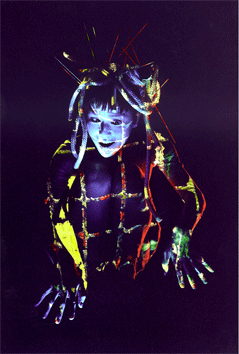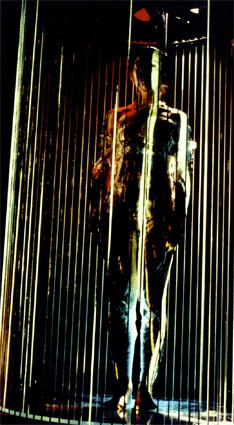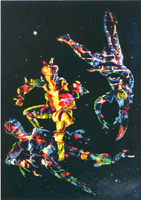
Aesthetic construction of light and movement, sound and music, developed by Gustav Gisiger and Michael Sievert.
A contrary picture to the virtual world of laser and holography, the transformation of light and sound as a passing, volatile, and mobile element that symbolizes its provisionalness and spectacularity.
An original game between order and chaos. A light and sound area combined together creating an effective synthesis of the arts.
The "théâtre imaginaire" of Gustav Gisiger and Michael Sievert.
A text by PD Dr. Beatrix Nobis, Scientist of the Arts, University of Hildesheim (excerpts):
Today, more than eighty years after Laszlo Moholy Nagy invented the “Light requisite of an electrical stage,” an “apparatus for the demonstration of light and movement features”, we believe ourselves to be far from the childlike seeming experiments of the early avant-garde with the fossil energy sources of their time.
The technical and electronic developments of the past decades do not only give the media age to us, but is also established in art, theater and video performance.
But laser beam technology and holography, probably the most impressive optical innovations, are lost in the meantime to the attraction of the visual sensation to a large extent:
They are hardly still more than a vaudeville act, a means for producing more eye-deceptively sleight of hand and magic tricks.
Their charm will have expired as soon as people have begun to see through the art; the thrill is gone, a fate that will be shared among the other artistic media that delivers a similar message, and ultimately fades out as a rush of staleness and redundancy.

The director Gustav Gisiger and the composer Michael Sievert developed a light and a sound area with the title théârtre imaginaire, which does without the camouflage tactics of virtual projections.
Their technical equipment is invention-rich and sophisticated, and is not based on just showing off, which one practices today so gladly in the alchemistic laboratories of the computer industry.
The technical apparatus reflects the methodology of the creator, it remains clear as an event, which was developed from an idea to its autonomous implementation.
The authenticity of the expressions doesn't only make the idea suppliers independent in a completely pragmatic sense, but also coins/shapes the requirement of the production because it aims at the basic experience of the “synthesis of the arts”, and as a means of organization which includes the questionableness of this striving at the same time.**
The "théârtre imaginaire" is an aesthetic construction of light and movement, sound and music.
It is a product, which works with coincidence and nevertheless is counted as the succession of subtly together-sounding, optical and acoustic operations of perception. It demonstrates its ironical ambivalence and at the same time its “mechanical” inadequacy and possesses therefore something from stage action, which savorably transfers the dramatic moment and at the same time possesses the condition of the provisional and contestable expression:

The illusion reveals itself with cultivated casualness as beautiful light, approved to play with order and chaos, which is understood to have produced the birth of the tragedy from the spirit of the music and the light as therapeutic agent against medial depletion of skepticism and reason.
Gisigers and Sieverts "théârtre imaginaire" is the idea of Moholy-Nagys "Light requisite," also Oskar Schlemmers “Triadic ballet” and Nicholas Schäfers “lumino-dynamic” constructions , and is closer to all audiovisual media pageants of our time.
It is a contrary picture to the virtual world, which itself offers incessantly concretness and nevertheless offers nothing else, as a matte reflection of reality, which exposes itself all the more clearly as untruly, yet it makes itself more convincing, it is not the suitable medium for the pragmatic accomplishment of anything more than the “said and done” feeling that is created.




